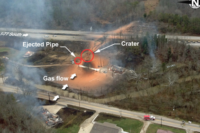A fatigue crack was the probable cause of a 2017 pipeline rupture in South Dakota that spilled thousands of gallons of crude oil, according to a pipeline accident brief released by the National Transportation Safety Board (NTSB).
The TransCanada Corporation, Keystone Pipeline ruptured near Amherst Nov. 16. Keystone’s Supervisory Control and Data Acquisition system detected the leak but approximately 5,000 barrels of crude oil were spilled before Keystone’s Operational Control Center in Calgary, Alberta, shut down the pipeline. There were no injuries or fatalities associated with the incident.
(The photo above from the Pipeline and Hazardous Materials Safety Administration shows the ruptured pipe section after it was cut at the point of rupture and extracted for transportation to the NTSB Materials Laboratory in Washington.)
The focus of the limited investigation into the incident was a metallurgical evaluation of the ruptured pipe. Materials engineers in the NTSB Materials Laboratory used optical and scanning electron microscopes and energy dispersive spectroscopy to examine the fracture surface and adjacent exterior pipe surfaces to determine the mode of fracture.
The NTSB determined that the fatigue crack was likely the result of mechanical damage to the pipe exterior caused by a metal-tracked vehicle during pipeline installation. The fatigue crack grew and extended in-service to a critical size, resulting in the rupture of the pipeline.
The docket contains the pipeline accident brief and investigative materials considered by the NTSB. The public docket is available at https://goo.gl/RLDWSd.



